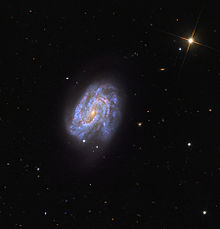| NGC 157 | |
|---|---|
 VLT image of NGC 157 VLT image of NGC 157 | |
| Observation data (J2000 epoch) | |
| Constellation | Cetus |
| Right ascension | 00 34 46.751 |
| Declination | −08° 23′ 47.36″ |
| Redshift | 0.0055 |
| Heliocentric radial velocity | 1651 km/s |
| Distance | 39.4 Mly (12.1 Mpc) 75 Mly (23 Mpc) |
| Apparent magnitude (V) | 10.4 |
| Apparent magnitude (B) | 11.07 |
| Characteristics | |
| Type | SAB(rs)bc |
| Size | 90 kly |
| Apparent size (V) | 4.0′ × 2.4′ |
| Other designations | |
| MCG -02-02-056, PGC 2081, 2MASSX J00344675-0823473 | |
NGC 157 is an intermediate spiral galaxy in the constellation of Cetus, positioned about 4° east of the star Iota Ceti. This galaxy can be viewed from suburban skies using a moderate-sized telescope. It was discovered on December 13, 1783 by William Herschel. The compiler of the New General Catalogue, John Louis Emil Dreyer noted that NGC 157 was "pretty bright, large, extended, between 2 considerably bright stars". It is a relatively isolated galaxy; the nearest other galaxy of comparable luminosity lies at a separation of 4.2 Mly (1.3 Mpc).

The morphological classification of NGC 157 is SAB(rs)bc, indicating this is a weakly-barred spiral galaxy (SAB) with a transitional ring structure (rs) and moderate to loosely-wound arms (bc). The plane of the galaxy is inclined at an angle of 61.8° to the line of sight from the Earth. It has symmetric arms that become flocculent in the outer parts, breaking into multiple arms. The rotation curve for this galaxy undergoes a sharp decline, suggesting a low mass or a small dark matter halo. It is considered a quiescent galaxy, showing little star formation activity. However, there is a starburst region in the nucleus forming new stars at the rate of about one solar mass per year.
This galaxy has been host to two observed supernova events. The first, 2009em, was discovered 5 May 2009, about 34″ west and 10″ south of the galaxy core. It was determined to be a Type Ic supernova. On 5 May 2022, Type Ic supernova event SN 2022jli was observed in NGC 157, reaching a peak magnitude of 14.4.
References
- ^ Skrutskie, Michael F.; et al. (1 February 2006). "The Two Micron All Sky Survey (2MASS)". The Astronomical Journal. 131 (2): 1163–1183. Bibcode:2006AJ....131.1163S. doi:10.1086/498708. ISSN 0004-6256. S2CID 18913331.
- ^ "NGC 157". SIMBAD. Centre de données astronomiques de Strasbourg. Retrieved 2015-09-30.
- ^ Tully, R. Brent; et al. (August 2016). "Cosmicflows-3". The Astronomical Journal. 152 (2): 21. arXiv:1605.01765. Bibcode:2016AJ....152...50T. doi:10.3847/0004-6256/152/2/50. S2CID 250737862. 50.
- Moore, T.; et al. (October 2023). "SN 2022jli: A Type Ic Supernova with Periodic Modulation of Its Light Curve and an Unusually Long Rise". The Astrophysical Journal Letters. 956 (1): L31. arXiv:2309.12750. Bibcode:2023ApJ...956L..31M. doi:10.3847/2041-8213/acfc25. ISSN 2041-8205.
- ^ O'Meara, Stephen James (June 14, 2007). Herschel 400 Observing Guide. Cambridge University Press. p. 303. ISBN 9780521858939.
- ^ Crowther, Paul A. (January 2013). "On the association between core-collapse supernovae and H ii regions". Monthly Notices of the Royal Astronomical Society. 428 (3): 1927–1943. arXiv:1210.1126. Bibcode:2013MNRAS.428.1927C. doi:10.1093/mnras/sts145.
- ^ ">New General Catalog Objects: NGC 150 - 199". Retrieved 2015-09-30.
- ^ Zobnina, D. I.; Zasov, A. V. (April 2020). "Galaxies with Declining Rotation Curves". Astronomy Reports. 64 (4): 295–309. arXiv:2003.08845. Bibcode:2020ARep...64..295Z. doi:10.1134/S1063772920050054.
- Zhu, Ming; et al. (December 2009). "Tracing Molecular Gas Mass in Extreme Extragalactic Environments: An Observational Study". The Astrophysical Journal. 706 (2): 941–959. arXiv:0908.1600. Bibcode:2009ApJ...706..941Z. doi:10.1088/0004-637X/706/2/941.
- Sempere, M. J.; Rozas, M. (January 1997). "Dynamical model of the grand-design spiral galaxy NGC 157". Astronomy and Astrophysics. 317: 405–415. Bibcode:1997A&A...317..405S.
- Monard, L. A. G. (May 2009). Green, D. W. E. (ed.). "Supernova 2009em in NGC 157". Central Bureau Electronic Telegrams. 1798: 1. Bibcode:2009CBET.1798....1M.
- Navasardyan, H.; Benetti, S. (May 2009). Green, D. W. E. (ed.). "Supernova 2009em in NGC 157". Central Bureau Electronic Telegrams. 1806: 1. Bibcode:2009CBET.1806....1N.
- "Transient Name Server entry for SN 2022jli". Retrieved 21 March 2023.
External links
 Media related to NGC 157 at Wikimedia Commons
Media related to NGC 157 at Wikimedia Commons
| Astronomical catalogs | |
|---|---|
| NGC | |
| PGC | |